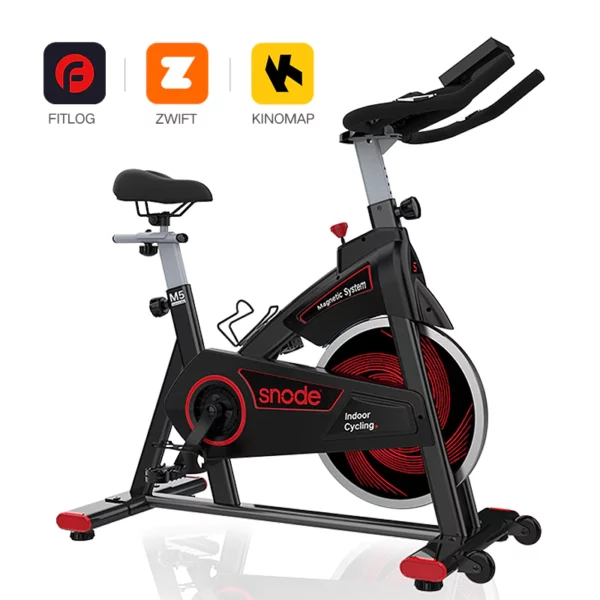To troubleshoot a Snode Indoor Cycling Bike, check for loose connections and ensure proper assembly. Examine the resistance system for blockages.
Snode Indoor Cycling Bikes are popular for home workouts. Occasionally, users may encounter issues affecting performance. Common problems include noise, resistance issues, and display malfunctions. Identifying the root cause can save time and money. Simple fixes often resolve the problem.
For instance, tightening bolts can eliminate noise. Regular maintenance ensures smooth operation. Keeping the bike clean and lubricated prolongs its lifespan. Reading the user manual helps understand the bike’s features and troubleshooting steps. If problems persist, contacting customer support is advisable. They provide expert guidance and necessary parts. Proper care ensures a reliable workout experience.
Common Issues
Using a Snode Indoor Cycling Bike can be a great way to stay fit. Yet, you may face some common issues. These can impact your workout experience. This section will address some of the most frequent problems.
Unstable Bike
An unstable bike can be frustrating. It can also be unsafe. There are a few reasons why your bike might wobble.
- Check if the bike is on a flat surface.
- Ensure all bolts and screws are tight.
- Inspect the stabilizers for any damage.
Use a level to confirm the bike is even. Tighten any loose parts with a wrench. If the problem persists, you may need to replace the stabilizers.
Resistance Problems
Resistance issues can disrupt your workout. Here are some common causes and solutions.
| Problem | Solution |
|---|---|
| Resistance not changing | Check the resistance knob. It might be loose. |
| Resistance too high | Inspect the brake pad. It might need replacing. |
| Resistance too low | Adjust the resistance belt. It might be slipping. |
Always keep the bike clean. Dirt can affect the resistance mechanism. Regular maintenance can prevent many issues.

Credit: www.amazon.com
Stabilizing The Bike
Ensuring that your Snode Indoor Cycling Bike is stable is crucial for a safe and effective workout. Stabilizing the bike can prevent injuries and improve your riding experience. Follow these tips to ensure your bike is steady and secure.
Leveling The Bike
First, check if the bike is level. Uneven bikes can wobble and cause discomfort.
- Place the bike on a flat surface.
- Use a spirit level to check the bike’s balance.
- Adjust the feet of the bike to ensure it is level.
Most indoor bikes have adjustable feet. Turn these feet clockwise or counterclockwise to raise or lower them. Ensure the bike is steady after adjustments.
Checking Floor Surface
The floor surface plays a vital role in bike stability. Ensure the surface is even.
- Check for any bumps or uneven spots on the floor.
- Place a rubber mat under the bike to enhance stability.
- Ensure the mat is large enough to cover the bike’s base.
A rubber mat not only stabilizes the bike but also protects your floor. It reduces noise and vibrations during your workout.
| Step | Description |
|---|---|
| 1 | Place the bike on a flat surface |
| 2 | Use a spirit level to check balance |
| 3 | Adjust the feet for leveling |
| 4 | Check floor surface for bumps |
| 5 | Use a rubber mat for stability |
Follow these steps to ensure your Snode Indoor Cycling Bike is stable. A stable bike provides a safer and more enjoyable workout experience.
Fixing Resistance
Dealing with resistance issues on your Snode Indoor Cycling Bike can be frustrating. The good news is, fixing resistance problems is usually straightforward. Below, you’ll find step-by-step guides to help you adjust the resistance knob and lubricate the flywheel.
Adjusting Resistance Knob
The resistance knob controls how hard it is to pedal. If it’s too easy or too hard, you may need to adjust it.
- Locate the resistance knob near the handlebars.
- Turn the knob clockwise to increase resistance.
- Turn the knob counterclockwise to decrease resistance.
- Test the bike after each adjustment to ensure proper resistance.
Lubricating The Flywheel
A well-lubricated flywheel ensures smooth and quiet operation. If you hear noise or feel resistance issues, it might be time to lubricate.
- First, unplug the bike for safety.
- Remove the cover to access the flywheel.
- Apply a few drops of lubricant to the flywheel’s moving parts.
- Rotate the flywheel manually to distribute the lubricant evenly.
- Replace the cover and plug the bike back in.
| Step | Action |
|---|---|
| 1 | Unplug the bike |
| 2 | Remove the cover |
| 3 | Apply lubricant |
| 4 | Rotate the flywheel |
| 5 | Replace the cover and plug back in |
By following these simple steps, you’ll have your Snode Indoor Cycling Bike running smoothly in no time. Happy cycling!
Noise Reduction
Experiencing noise from your Snode Indoor Cycling Bike? This can be annoying and distracting. Let’s explore some practical steps to reduce that noise. We’ll inspect the pedals and tighten bolts to ensure a quiet ride.
Inspecting Pedals
Check the pedals for any loose parts. Loose pedals can create unwanted noise. Follow these steps to inspect and fix them:
- Turn the bike upside down.
- Use a wrench to check the pedal tightness.
- Tighten any loose pedals.
If the pedals still make noise, check for damage. Replace damaged pedals to ensure a smooth ride.
Tightening Bolts
Loose bolts can also cause noise. Regularly check and tighten all bolts. Follow these steps:
- Locate all bolts on the bike.
- Use the right tool for each bolt.
- Tighten each bolt securely.
Pay special attention to bolts on the frame and seat. These areas often experience more stress and can loosen over time.
Screen Display Issues
Experiencing screen display issues on your Snode Indoor Cycling Bike? This can disrupt your workout routine. Let’s explore some common solutions to get your display back on track.
Resetting The Console
If your screen is frozen or displaying incorrect data, resetting the console might help. Follow these simple steps:
- Turn off the bike using the main power switch.
- Wait for 30 seconds to ensure a full reset.
- Turn the bike back on and check the display.
If the issue persists, move to the next step.
Replacing Batteries
A dim or blank screen often indicates weak batteries. Here’s how to replace them:
| Step | Description |
|---|---|
| 1 | Locate the battery compartment behind the console. |
| 2 | Remove the cover using a screwdriver. |
| 3 | Take out the old batteries and dispose of them properly. |
| 4 | Insert new batteries, ensuring correct polarity. |
| 5 | Replace the cover and tighten the screws. |
Restart the bike and check if the screen display is working correctly.

Credit: www.ebay.com
Pedal Problems
Pedal problems on your Snode Indoor Cycling Bike can be frustrating. Whether the pedals are loose or need replacing, fixing these issues is crucial for a smooth ride. Let’s explore common pedal problems and how to solve them.
Securing Pedals
Loose pedals can cause instability. Ensure your bike pedals are secure by following these steps:
- Position the pedal horizontally.
- Use a wrench to tighten the pedal bolt.
- Check for any wobbling or movement.
If the pedal is still loose, inspect the pedal threads. Worn threads may require replacement.
Replacing Pedals
Sometimes, pedals need to be replaced. Follow these steps to replace your bike pedals:
- Use a wrench to loosen the pedal bolt.
- Remove the old pedal from the crank arm.
- Align the new pedal with the crank arm.
- Hand-tighten the new pedal.
- Use a wrench to fully secure the new pedal.
Test the new pedals for stability before use.
Seat Adjustments
Proper seat adjustments on your Snode Indoor Cycling Bike are key for a comfortable ride. The correct seat height and position help avoid injuries and improve performance. Follow the steps below to adjust your bike seat effectively.
Height Adjustment
Adjusting the seat height ensures your legs extend properly during pedaling. Follow these steps:
- Stand next to your bike.
- Raise or lower the seat to match your hip height.
- Sit on the bike with your feet on the pedals.
- Check if your legs are slightly bent at the lowest pedal position.
If your knees are too bent or too straight, adjust the seat height again. Repeat the steps until you find the perfect height.
Positioning The Seat
The seat position affects your balance and comfort. Follow these instructions:
- Loosen the seat adjustment knob under the seat.
- Slide the seat forward or backward to find a comfortable position.
- Tighten the knob securely after adjusting the seat.
- Sit on the bike and pedal to test the position.
Your knees should align with your feet and not go over your toes. Adjust as needed to achieve this alignment.
Proper seat adjustments make your cycling experience enjoyable and safe. Always ensure the seat is secure before every ride.

Credit: maxumfitness.ca
Maintaining The Bike
Maintaining the Snode Indoor Cycling Bike is essential for peak performance. Routine maintenance prolongs the bike’s lifespan. It also ensures a smooth and safe workout experience. Below, find steps for regular cleaning and routine inspections.
Regular Cleaning
Regular cleaning keeps the bike in top condition. Use a soft cloth to wipe down the bike after each use. Sweat can cause corrosion. Clean handlebars, seat, and frame thoroughly.
Avoid using harsh chemicals. Mild soap and water are best. Dry all parts completely. This prevents rust and damage.
Routine Inspections
Routine inspections catch potential problems early. Check the bike weekly. Look for loose bolts and screws. Tighten them if needed.
Inspect the pedals and crank arms. Ensure they are secure. Check the belt or chain for signs of wear. Replace if necessary.
| Component | Inspection Frequency | Action Required |
|---|---|---|
| Bolts and Screws | Weekly | Tighten |
| Pedals | Weekly | Ensure secure |
| Belt or Chain | Monthly | Check for wear |
Also, inspect the flywheel. It should spin smoothly. If not, adjust it. Lubricate moving parts monthly. This ensures a quiet ride.
Keeping a maintenance log helps track inspections. Note dates and actions taken. This keeps you organized.
Frequently Asked Questions
How Do You Control The Resistance On An Indoor Cycling Bike?
Turn the resistance knob or lever to adjust the tension on an indoor cycling bike. Increase for harder pedaling, decrease for easier.
What Function Does A Resistance Knob Perform On An Indoor Cycling Bike?
The resistance knob on an indoor cycling bike adjusts the difficulty level. It increases or decreases the pedal resistance, simulating various terrains.
How To Buy An Indoor Cycling Bike?
Choose a bike with adjustable resistance. Check for a comfortable seat and handlebars. Ensure it fits your space. Read reviews and compare prices. Purchase from a reputable retailer.
Why Is My Snode Bike Not Turning On?
Check the power connection and ensure the plug is securely inserted. Verify that the outlet is working. If the bike still doesn’t turn on, inspect the power cord for any visible damage. You may need to contact Snode customer support for further assistance.
Conclusion
Troubleshooting your Snode Indoor Cycling Bike ensures a smooth and efficient workout. By addressing common issues, you extend the bike’s life. Regular maintenance and quick fixes can prevent major problems. Keep this guide handy for future reference. Stay active and enjoy a seamless cycling experience at home.
